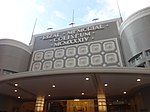Adventist Medical Center Manila
1929 establishments in the Philippines20th-century architecture in the PhilippinesBuildings and structures in PasayHospital buildings completed in 1929Hospitals affiliated with the Seventh-day Adventist Church ... and 4 more
Hospitals established in 1929Hospitals in Metro ManilaPrivate hospitals in the PhilippinesProtestant hospitals in the Philippines
The Adventist Medical Center Manila, (formerly Manila Adventist Medical Center; also Manila Sanitarium and Hospital), is an acute care, tertiary, non-stock, non-profit, and self-supporting private hospital that is located within Pasay in Metro Manila, Philippines. It was established in July 1929 by a missionary doctor - Horace Hall. The hospital is part of a chain of more than 500 health care institutions worldwide operated by the Seventh-day Adventist Church. It is licensed by the Center for Health Development of the Philippine Department of Health, accredited by Medicare, the Philippine Hospital Association and the American Hospital Association.
Excerpt from the Wikipedia article Adventist Medical Center Manila (License: CC BY-SA 3.0, Authors).Adventist Medical Center Manila
Donada Street, Pasay Zone 3 (District 1)
Geographical coordinates (GPS) Address Website External links Nearby Places Show on map
Geographical coordinates (GPS)
| Latitude | Longitude |
|---|---|
| N 14.555903 ° | E 120.995275 ° |
Address
Adventist Medical Center Manila
Donada Street 1945
1300 Pasay, Zone 3 (District 1)
Philippines
Open on Google Maps






